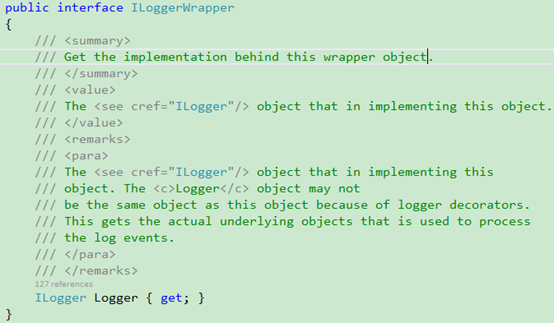Log4net源码View之Logger解析
1.简介
Logger是Log4net的三大核心载体之一,搞清楚它的意义很重大。另外两个分别是Appender和Layout。其对应关系为一个Logger对应多个Appender,一个Appender对应一个Layout。
对于Log4net的内部实现,ILogger才是接口(所有日志需要实现的——Interface that all loggers implement)。
为什么不是我们所使用的ILog接口呢?实际上,ILog是对ILogger进行了包装,是典型的Wrapper模式,话说不仔细看的话,还真搞不清楚它们的关系。
下图表明了关系:ILog——>ILoggerWrapper——>ILogger.


所以,从下面开始,请先忽略ILog接口,将关注点放在ILogger上,这也是本文的重点。
2.ILogger接口
|
方法 |
含义 |
|
string Name{ get; } |
获取ILogger的名称 |
|
Log(Type callerStackBoundaryDeclaringType, Level level, object message, Exception exception); |
将需要记录的信息(level、msg、ex)变成一个LoggerEvent对象,然后将LoggerEvent对象分发到各个Appender。 |
|
void Log(LoggingEvent logEvent); |
直接记录一个LoggerEvent |
|
bool IsEnabledFor(Level level); |
检查某级别是否可用 |
|
ILoggerRepository Repository { get; } |
ILogger所在的仓储 |
从接口结合源码可以得出:
2.1 仓储
通过Repository可以找到ILogger所在的仓储,得到对应的分组(Repository Group);
设计思想:
将多个日志对象进行分组,以便于管理。比如用户User,用户组UserGroup,其中UserGroup就是分组。
而Repository除了有分组的意义之外,还有存储的作用,可以理解为带有缓存功能的工厂(Factory+Cache)。
2.2 LoggerEvent
LoggerEvent又是什么呢?(很早以前看到LoggerEvent时,一直很纠结为什么要这样取名?是为了让别人看不懂源码吗?仔细揣摩之后,比如WCF的Messaging,EBaySDK中的Request,只是某个语境下的一个特性称谓)
设计思想:
LoggerEvent可以理解为一个信封Envelope,类似于WebService中soap的概念,也类似于MessageQueue中的Messaging的设计。其主要用来包装与消息(object message)有关的数据。这样,通过将LoggerEvent分发给Appender,就实现了输出到多个终端。如下代码:
-
{
-
//......
-
int writes = 0;
-
for (Logger c = this; c != null; c = c.Parent)
-
{
-
if (c.m_appenderAttachedImpl != null)
-
{
-
// Protected against simultaneous call to addAppender, removeAppender,...
-
c.m_appenderLock.AcquireReaderLock();
-
try
-
{
-
if (c.m_appenderAttachedImpl != null)
-
{
-
writes += c.m_appenderAttachedImpl.AppendLoopOnAppenders(loggingEvent);
-
}
-
}
-
finally
-
{
-
c.m_appenderLock.ReleaseReaderLock();
-
}
-
}
-
//......
-
}
-
}
其中,m_appenderAttachedImpl为Appender的集合,AppendLoopOnAppenders循环将LoggerEvent添加到Appender。
2.3 LoggerEventData
"信封"里的数据是什么呢?——LoggerEventData对象。
-
public struct LoggingEventData
-
{
-
public string LoggerName;
-
public Level Level;
-
public string Message;
-
public string ThreadName;
-
public DateTime TimeStamp;
-
public LocationInfo LocationInfo;
-
public string UserName;
-
public string Identity;
-
public string ExceptionString;
-
public string Domain;
-
public PropertiesDictionary Properties;
-
}
最常用的数据,TimeStamp,Message,ExceptionString
3.抽象类Logger

特点:
1)通过继承IAppenderAttachable接口,这样Logger与IAppender之间就有一对多的包含与调用关系;
2)Logger具有层次结构,公布了类型为Logger的父亲指针Parent;
3)通过实现ILogger(具体是使用了LoggerEvent对象),则将日志的整体包装起来;
4.ILoggerFactory
用于创建Logger对象

其在DefaultLoggerFactory中的实现为:
-
public Logger CreateLogger(ILoggerRepository repository, string name)
-
{
-
if (name == null)
-
{
-
return new RootLogger(repository.LevelMap.LookupWithDefault(Level.Debug));
-
}
-
return new LoggerImpl(name);
-
}
其中,LoggerImpl对象继承自Logger,并没有做什么特殊的改变。
RootLogger带有一个默认的Level。
总结:
Logger其实提供了一种处理中心的功能,类似分发站,将message发给各个Appender。
待续~


